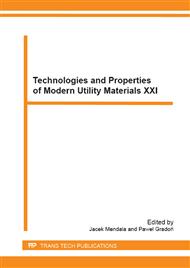[1]
J. Kliber, I. Mamuzic, Selected new technologies and research themes in materials forming, Metalurgija 49 (3) (2010) 169-174.
Google Scholar
[2]
Z. Cyganek, K. Rodak, F. Grosman, Influence of rolling process with induced strain path on aluminium structure and mechanical properties, Arch. Civ. Mech. Eng. 13 (1) (2013) 7-13.
DOI: 10.1016/j.acme.2012.10.008
Google Scholar
[3]
W. Bochniak, K. Marszowski, A. Korbel, Theoretical and practical aspects of the production of thin-walled tubes by the KOBO method, J. Mater. Process. Technol. 169 (1) (2005) 44-53.
DOI: 10.1016/j.jmatprotec.2005.02.258
Google Scholar
[4]
W. Bochniak, A. Korbel, R. Szyndler, R. Hanarz, F. Stalony-Dobrański, L. Błaż, P. Snarski, New forging method of bevel gears from structural steel, J. Mater. Process. Technol. 173 (1) (2006) 75-83.
DOI: 10.1016/j.jmatprotec.2005.09.028
Google Scholar
[5]
M. Greger, R. Kocich, L. Čížek, Grain refining of Cu and Ni-Ti shape memory alloys by ECAP process, J. of Achievements in Materials and Manufacturing Engineering 20 (1-2) (2007) 247-250.
Google Scholar
[6]
E. Bruder, O. Görtan, P. Groche, C. Müller, Severe plastic deformation by equal channel angular swaging, Materials Science Forum 667-669 (2011) 103-107.
DOI: 10.4028/www.scientific.net/msf.667-669.103
Google Scholar
[7]
J-Ch. Lee, H-K. Seok, J-H. Han, Y-H. Chung, Controlling the textures of the metal strips via the continuous confined strip shearing (C2S2) process, Materials Res. Bulletin 36 (2001) 997-1004.
DOI: 10.1016/s0025-5408(01)00557-8
Google Scholar
[8]
A. Korbel, W. Bochniak, R. Ostachowski, L. Błaż, Visco-plastic flow of metal in dynamic conditions of complex strain scheme, Metall. Mater. Trans. A 42A (2011) 2881-2897.
DOI: 10.1007/s11661-011-0688-x
Google Scholar
[9]
K. Rodak, J. Pawlicki, M. Tkocz, Deformation-induced grain refinement in AlMg5 alloy, Solid State Phenom., 191 (2012) 37-44.
DOI: 10.4028/www.scientific.net/ssp.191.37
Google Scholar
[10]
K. Rodak, J. Pawlicki, M. Tkocz, Mechanical and microstructural aspects of severe plastic deformation of austenitic steel, IOP Conf. Series: Mater. Sci. Eng. 35 (2012).
DOI: 10.1088/1757-899x/35/1/012008
Google Scholar
[11]
K. J. Kurzydłowski, Microstructural refinement and properties of metals processed by severe plastic deformation, Bulletin of the Polish Academy of Sciences, Tech. Sci. 52 (4) (2004) 301-311.
Google Scholar
[12]
A. Wrożyna, G. Niewielski, K. Rodak, D. Kuc, F. Grosman, J. Pawlicki, The impact of compression with oscillatory torsion on the structure change in copper, Arch. Civ. Mech. Eng. 7 (2) (2007) 39-46.
DOI: 10.1016/s1644-9665(12)60209-x
Google Scholar


